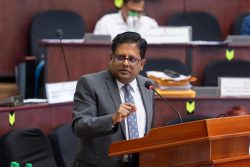Experts from the drug monitoring centres in Latin America have expressed concern over the rising tendencies in drug consumption in most countries, and the regional use of synthetic drugs, the adulteration of which is a top concern.
Representatives of 17 Latin American countries met in the Uruguayan capital Montevideo from Monday to Friday last week to review the current situation of drug use in the region, the Organization of American States said in a press release on Friday.
Organized by the Inter-American Drug Abuse Control Commission (CICAD) of the Secretariat for Multidimensional Security of the OAS, the event was held in the headquarters of the Spanish Agency for International Development Coopera-tion in the Uruguayan capital and was supported by the national drug plans of that country and that of the United States State Department.
During the meeting, the Handbook for the Creation of National Drug Monitoring Centers was launched. The handbook was put together jointly by the European Monitoring Center for Drugs and Drug Addiction and the CICAD, and is based on the experiences of the last two decades.
“We believe that with the strengthening of the organizations responsible for drug-related data there will be more information available and therefore better public policies,” said Alexis Goosdeel of the European Monitoring Center, coordinator of the national drug monitoring centres in Europe and the document’s main author.
“We are very worried that young people are buying Ecstasy and consuming whatever they get, given the health risks involved,” said Francisco Cumsille, coordinator of the OAS Observatory on Drugs, regarding the recent study by Colombia’s National Office of Drug Control.
Participants in the debates addressed the capacity of states to generate relevant and trustworthy information that supports the elaboration of public policies. “While there has been progress, our data systems are still too weak to allow us to understand what is happening in most countries, making very urgent the consolidation of these systems that would allow us to elaborate public policies based on available scientific evidence,” said Rafael Franzini Batlle, CICAD Assistant Executive Secretary. Furthermore, a manual for the establishment and development of national drug monitoring centers was jointly elaborated with the European Monitoring Center for Drugs and Drug Addiction, and was presented by Alexis Goosdeel.
The Secretary for Multidimen-sional Security of the OAS, Ambassador Adam Blackwell, said that “drugs continue to be the principal motor for criminal gangs; nevertheless not all control initiatives must be rooted in the enforcement of the law,” referring to other factors that contribute to drug trafficking. Blackwell pointed out that “the initiatives of demand reduction are very important taking into account that a small fraction of all consumers accounts for the greatest proportion of the market.”
He also noted that “the importance of following the money and, when seized, place it at the disposal of drug addiction treatment and the improvement of law enforcement services.”
Alcohol consumption
Meanwhile, the Secretary of the National Commission on Drugs of Uruguay, Milton Romani, said that “addressing the excessive consumption of alcohol is a high priority to reduce the harm related to this tendency and block the road to other drugs,” adding that “the regional phenomenon of cocaine paste must be confronted from a social health perspective, through local community initiatives focusing on social integration.”
OAS member states approved last May a new Hemispheric Drug Strategy that emphasizes respect for human rights, addresses drug addiction as a chronic and recurrent disease, and proposes a broader focus on drug treatment.
One of the fundamental pillars of the new strategy is improving information and therefore the elaboration of public policies. “We will not be successful in our policies if we do not know holistically the problem that we are facing,” said Francisco Cumsille, the event’s coordinator.
The results of this debate and analysis will be presented during CICAD’s next meeting in December, the release added.








